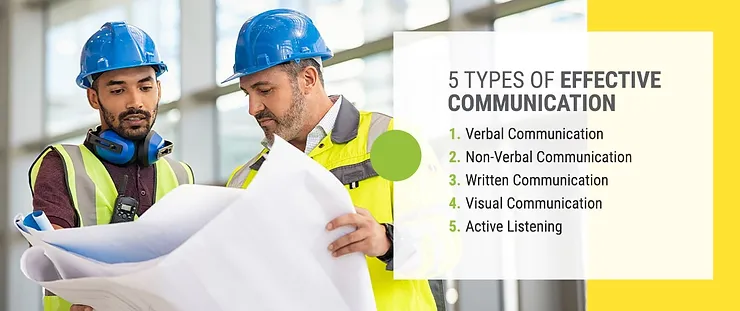YOUR EFFECTIVE WORKPLACE COMMUNICATION GUIDE
Communicating is something we all do. But when did you last consider how effective your communication is in the workplace? What would your employees say? Getting communication right is something you can achieve — it just takes consideration and intentionality. Let’s look at the steps you can take to become an excellent and effective communicator.
What Is Effective Communication?
Effective communication gets your point across in a clear and understandable way. Communicating effectively in the workplace is the foundation of all you do. Everyone must be on the same page to work together as a team and meet your business goals. Effective communication goes much deeper than the words you say or the emails you send out to your team. As a supervisor, your goal is to figure out whether each employee understands your communication and is on board.
Employees feel they belong when there is a common understanding within your team. It boosts engagement and improves job satisfaction. Many believe that effective communication ends with eloquent words and easy-to-follow directives, but you truly become an effective communicator once you actively listen.

5 Types of Effective Communication
You may be familiar with the four types of communication — verbal, non-verbal, written and visual — but one other form needs to be utilized: active listening. An effective communicator can successfully use these five types of communication in the appropriate workplace situations.
1. Verbal Communication
Verbal communication is all about the words you say and how you speak. Some verbal communication methods in the workplace include presentations, in-person meetings, phone calls and even casual conversations.
How do you make your team feel when you speak? When presenting the company goals, are you enthusiastic in your delivery? Your tone is contagious and plays a role in how your team will respond to your communication. Verbal communication is a two-way street, so make sure you leave time for employees to ask questions and give feedback.
2. Non-Verbal Communication
Effective communicators know body language is just as important as words. Preparing an excellent presentation and saying what your team wants to hear may be easy, but the true meaning of what you say is communicated through your body language.
Research shows that 55% of effective communication is done through body language. Non-verbal communication involves posture, facial expressions, eye contact and and physical behavior. When your non-verbal communication matches your verbal communication, your message is sincere and is better received.
3. Written Communication
Written communication includes emails, messages, notices and any other written formats you may have in the workplace. Similar to verbal communication, keeping written messages concise and clear helps improve understanding and ensure the message is well received.
Pay attention to grammar, punctuation and spelling. Errors in written communication can distract readers from the essence of the message.
–Effective Communication Approachs–
4. Visual Communication
Visual communication is helpful when you need to communicate a complicated message. Charts, graphs, videos and infographics help break down complex information into a message that is easier for individuals to understand.
5. Active Listening
Active listening is essential for supervisors and other team members. Often, the focus is on speaking, but effective communication and active listening go hand-in-hand. Actively listen to your team to gain a deeper understanding and lead by example.
Give the individual your full attention and acknowledge that you are listening through non-verbal communication, such as nodding and eye contact. Pay attention to their body language for greater context to the true meaning. If you have questions, wait until they finish speaking, and show you understand by paraphrasing what they said. Active listening improves relationships with your team and shows you support and value their opinions.
Benefits of Effective Communication
To reach a common goal as a team, you need everyone to be on the same page. Effective communication unites and creates a supportive environment for employees to work together toward a common goal. Let’s take a look at some of the benefits:
- Reduces conflict: Miscommunication is how many conflicts begin. Team members can better understand and empathize with one another by practicing clear and effective communication.
- Improves working relationships: When employees feel understood and valued, it strengthens the bond within your team.
- Increases loyalty: When you value your employees, you want them to remain for the long term. Employees who feel valued and heard will uphold their commitment to your business.
- Encourages engagement: If you show your employees their contribution matters, it encourages them to continue speaking up. Team members want to see their valuable ideas accepted and implemented.
- Drives morale: Workers are motivated to do well when they understand how their roles contribute to the business’s success. When you communicate the importance of their work and provide constructive feedback, employees are empowered to carry out their roles effectively.
Workplace Communication Tips
Now you know what effective workplace communication is and why it’s essential for achieving success in your business, but how do you implement it in your workplace?
1. Keep It Clear and Concise
You want your team to understand and remember the important information from your communication. If it is filled with unnecessary details, they might lose interest or disregard the message completely. You can get straight to the point and be clear and accurate to avoid confusion.
Planning and creating a communication strategy will help you highlight the main points and stay on topic. Keep your goals in mind before you begin communicating, whether you want to educate your team on safety measures or change their minds about something.
2. Choose the Right Time
Schedule a meeting if you need a long time to communicate an important messa
ge. Your message will be lost if you approach an employee when they are busy. If you need their full attention, it’s better to set up a time that works for both of you.
3. Follow Up
Continue to ask questions after the initial meeting. Ensure employees understand how the communication affects them and reassure them that their contribution matters. If there are any misunderstandings, address them sooner rather than later to prevent any conflict or resentment from building up.
4. Give Feedback
Employees also need to know when they are doing well! Positive feedback helps to improve morale, shows workers they are valued and encourages more open communication. If you want your employees to give their best effort and approach their work positively, offer encouraging feedback.
Check out Safety Made Simple’s Workplace Communication Courses Today
We want to help you create a better work environment by improving your workplace communication. When you know how to communicate with your employees effectively, you can work together and achieve success for your business. Check out our workplace communication courses online!
Joe Mlynek is a partner and subject matter expert at Safety Made Simple, LLC. He has over 20 years of experience in safety at the corporate level and as a consultant. He is a Certified Safety Professional (CSP) and Occupational Safety and Health Technician (OHST). Joe can be reached at joe.mlynek@safetymadesimple.com

